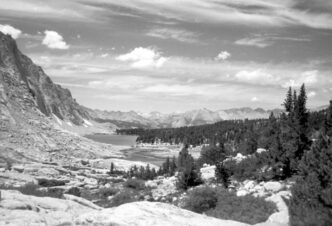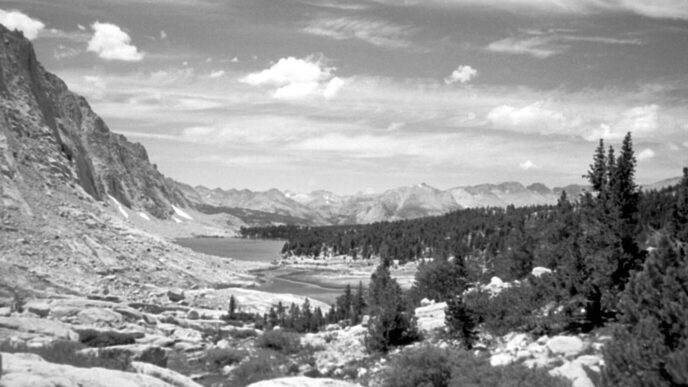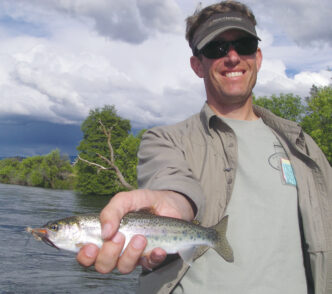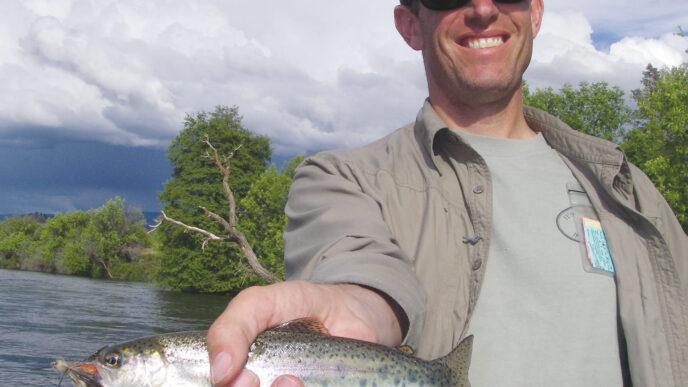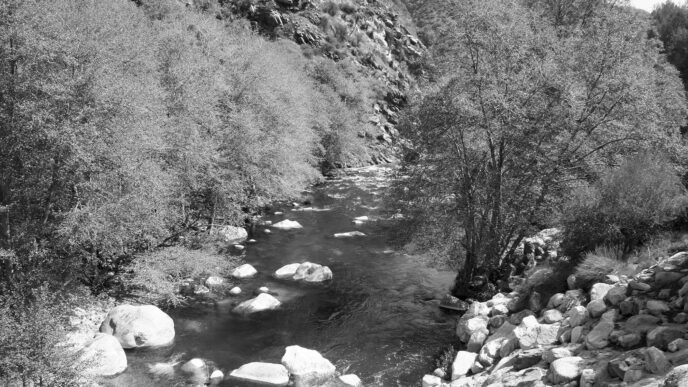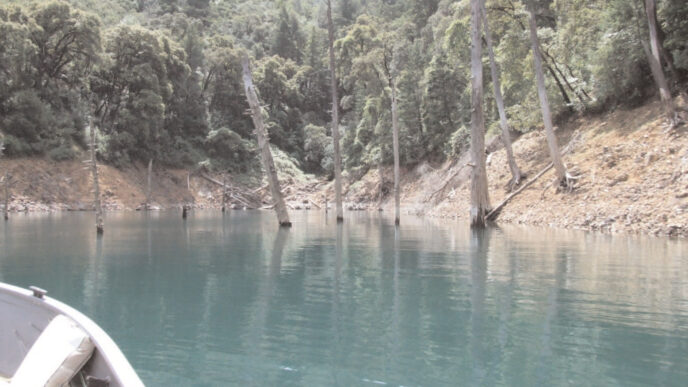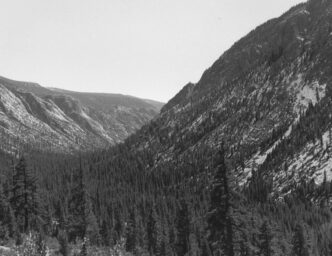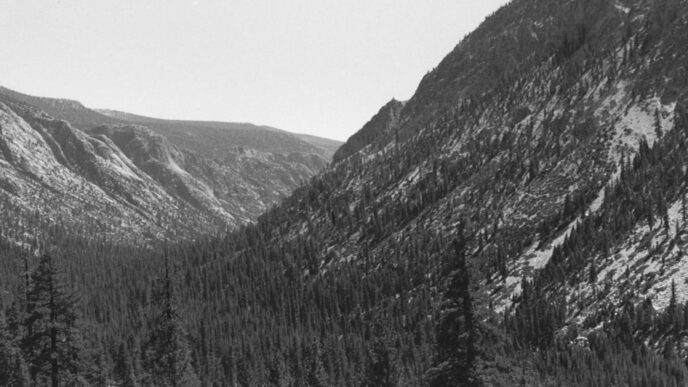A recent trip to Paso Robles, chasing great pinot vintages, reminded me of the fishing opportunities that abound in an area that isn’t thought of as one of our state’s premier angling destinations. My wife and I decided on the spur of the moment, during a break in the January weather, to make a drive down U.S. 101 and check out the Paso Robles’s restaurant scene as well as do some wine tasting. Next we would head on Highway 46 over the Coast Range to Cambria for a few days of beach walking, a visit to Cayucos, and a tour of San Simeon before heading up the Big Sur Highway to Carmel. Along the way, I would look for angling possibilities . . . from farm and vineyard ponds to lakes such as San Antonio, Nacimiento, Lopez, and Santa Margarita, as well as coastal access points for fly fishing the surf. I have learned to carry a fly rod wherever my travels will take me, and the Central Coast highway offers access to several beaches that can be fished. More adventurous souls could even bring a roof-top pontoon and brave the ocean to access reefs and kelp beds where you find rockfish that gobble large flies.
As we left the Salinas Valley, I remembered passing long ago the now-defunct Camp Roberts and gassing up in a scorching Paso Robles on my way to the U.C. Santa Barbara campus in Goleta. A decent grade-point average, a student deferment, and acceptance into graduate school kept me out of the Sixth Army and Camp Roberts’s hellhole. More recently, I had traveled several times to Lake Nacimiento chasing the white bass run.
A number of recollections stand out in my mind. The first involved the tales of an angling partner, Carl Mottice, of his duty at Camp Roberts and the Hunter Liggett Military Reservation in the mountains to the west. Neither of these destinations is a place where you would want to spend a summer. There is heat in the dry season and bone-chilling fog and wind in the winter. Pneumonia was a common illness among recruits there and at now defunct Fort Ord.
Carl made the best of a bad situation and drove his government-issue jeep up and down every road and goat trail in the Santa Lucia Mountains, looking for fish. He told tales of finding five-pound smallmouths in hard-to-reach stretches of the Nacimiento and San Antonio Rivers.
It was Carl’s tales that once helped a fishing buddy and me turn a less than memorable trip to Nacimiento into a banner angling experience. When white bass were first established in the lake, many newspaper and magazine articles featured the event. Fly fishers soon found that they could target the run each spring, sometime around Easter, when the fish moved to the upper reaches of the lake and into the tributary river for spawning. A cadre of anglers would make the trip up the lake to cast shad flies for the milling white bass.
My partner and I heard about the white bass run, and our adventure involved getting lost on the road in, tent camping, getting soaked in a torrential downpour, and getting lost again in a dense ground fog on the lake. As a result, we didn’t arrive at the upper end of the lake at first light, when the fishing is best. When we rounded the last up-lake bend, late in the morning, a row of boats was beached, and a crowd was on the shore, drinking beer and stronger libations. Angling notables Dan Blanton and Ed Given held court, and all lamented that the white bass hadn’t shown up. My partner and I shared a hot brandy, but after fifteen minutes of fish talk, we decided that we hadn’t come all that way just to jaw. We remembered Carl Mottice’s tales and slipped our boat back in the water, then ran upriver slowly with our prop just under the surface.
Rocks at the head of navigation forced us to beach our boat. We donned waders and vests and picked up our fly rods for a hike upriver. We were amazed at the volume of clear, blue water entering the lake and the incredible verdant spring scenery. Moss hung from every oak. The run in front of us looked inviting. We hoped that the river held smallmouths, but we really didn’t have a clue. My partner’s first cast with a small minnow streamer shot across the run. He mended line and let his fly swing down to where it hung in the current. As he stripped in to pick up for another cast, his rod bent over with a savage take. Five minutes later, a three-pound smallmouth lay on the beach.
We took turns casting into the slot and took over fifty smallmouths that morning. We kept four on a stringer for a campfire dinner. The rest we carefully released. Bait anglers on the far shore thought that we were violating the law and flagged down a Fish and Game warden on their way back down the lake.
The warden beached his boat and walked upriver to our special slot. He asked for our licenses and marveled at our success with the smallmouths. My partner fumbled for his wallet and realized that his license was on our truck’s dashboard back at the Nacimiento launch ramp. The warden was a good guy, and when I explained that we were both working on conservation projects with the DFG (my partner was the president of the Northern California Council of the Federation of Fly Fishers at the time, and I was chairman of the Little Truckee River Trout Restoration Task Force), he decided not to give us a citation. We continued fishing until the fabulous bite finally stopped.
When we got back to our boat, it was obvious that the warden hadn’t completely trusted us. Our boat had been gone over with a fine-tooth comb. Inside the forward deck hatch we found a pair of high-powered spotting binoculars. We speculated that the warden had been watching us and had inspected our boat for overlimit fish and any other violations. He had forgotten his very expensive binoculars.
On the long run back to the launch ramp and our campground, we stopped when our graph showed balls of bait with fish underneath. We had found the white bass! A dozen took our flies, and we added two to our dinner basket. Continuing down the lake, I spotted a Fish and Game boat and threw my throttle all the way forward to try and overtake him. The driver acted weird as we approached . . . as if we were a threat. I waved frantically and held up the binoculars. Finally he got the picture and allowed us to pull alongside. My partner leaned toward the warden’s boat and handed him the glasses as he said, “One good turn deserves another.” No words were exchanged. We heard later that the thousand-dollar cost of the binoculars would have come out of his meager salary. We made the long run back to camp and thoroughly enjoyed our tempura-battered, wok-fried bass that night.
If you want to fish nacimiento today, there is a fascinating country road that winds out of Paso Robles through beautiful hills and vineyard country. You can indulge in some wine tasting or stay in Paso Robles and partake of a number of very good restaurants. As the area’s wine region has expanded exponentially, so have dining opportunities at all price points. This was not true 20 or even 10 years ago. Santa Margarita Lake is close to Paso Robles and the Edna Valley wine region south of San Luis Obispo. Lopez Lake is east of Arroyo Grande and again close to Edna Valley and its fabled chardonnays. Combine the area’s angling potential with the wine-culture opportunities in all directions, and you have many reasons to make a visit.
When my wife and I arrived in Paso Robles this past January, we circled the downtown area and town square and found a vacant parking spot right in front of the Ortman Family Vineyards storefront. A tasting room in front of an open parking space was a good omen. The Ortman family started Meridian Vineyards and undertook a new Rhone varietal venture with the Ortman label. A family member was behind the tasting bar. After buying several bottles of a fabulous syrah, I asked where we should go for lunch, and then, on our return from across the courtyard, where we could find the best pinots. After lunch, we wound our way through the west side vineyards on our circuitous drive of thirty miles or so to Cambria and two nights on the coast. Standout wineries were Windward, Justin, Halter Ranch, and Adelaide. They are just a few of many stellar wineries the area, however. The proprietor of Windward mentioned the area’s June Pinot and Paella festival, and our reservations for that are already in. I’ve added top-water bass to the date, because I wrangled an invitation to fish several vineyard lakes, not to mention Nacimiento before the out-of-school water-ski crowd arrives.
Whether you are fishing or wine tasting, or both, several outstanding delicatessens around the Paso Robles town square can make you a fabulous picnic basket. Thomas Hill Organics in Paso Robles, just off the town square, where we enjoyed one of the best light lunches I’ve ever had, is a hangout for locals in the know. It is supported by Joe Thomas’s 10-acre organic produce farm. His wife, Debbie, runs the restaurant, wine shop, and wine bar, and she helped us plan our tasting explorations. A charming courtyard was warm in a bright January sun. I had hoped to pair a glass of viognier with their Madrid fried calamari sandwich, which came with pea tendrils, romesco sauce, aioli, and a field-greens salad, but they had run out of fresh squid. Disappointed, I opted for a Rogue Creamery cambozola panini with Thomas Hill Farms mustard greens. The panini dripped with melted cheese, and the beautiful, fresh greens in the salad were the best that I have ever tasted. My wife, Karen, had their house salad of field greens, persimmons, and a green olive vinaigrette. We shared. This restaurant is on our return list.
Our plan was to spend two nights on Moonstone Beach, then work up the Big Sur Highway to Lucia, explore beach access points and do some inland hiking. One of this winter’s largest storms was headed our way, however. On the advice of locals, we decided to cancel reservations at Lucia Lodge, rather than risk getting trapped by mudslides for several days. The Lodge’s rain check and dining room will bring us back . . . maybe during the Pinot and Paella event.
Excellent dining opportunities abound in Cambria, Cayucos, and on Moonstone Beach, near Cambria. We tried the Sea Chest Restaurant and Oyster Bar at Moonstone Beach. A crowd waited outside for the five o’clock opening. They don’t take reservations, and it’s cash or check, no credit cards. We arrived around 7:30 and were seated right away in the back room. A front dining room overlooks Moonstone Beach, and you can hear and see the breakers. The Sea Chest specializes in fish and oysters. A chalkboard tells you what is fresh that day. Petrale sole was one of the offerings; it had come from the docks at nearby Moro Bay. Both of us jumped at the chance to order it. Our waitress skipped to the kitchen to reserve us the last two portions and returned with a bottle of Tangent sauvignon blanc. Dinner is served with potatoes and fresh vegetables. You have the choice of Boston clam chowder or a fresh garden salad. We sipped the delightful wine and enjoyed Sea Chest’s nautical theme. The petrale sole was pan sautéed with very little oil and no dusting of flour. The delicate flavors of a fresh, delicate, white-meated local fish were not overpowered, as so often happens with more aggressive preparations.
The next morning, we drove north for our San Simeon tour. Forget the fishing, and forget the wine tours! San Simeon will blow you away, if not for the architecture and art, for the vistas of one of California’s most fabled ranches. We were glad that we had hit the road for a winter getaway.
A Web search kept popping up reviews of Ruddell’s Smokehouse in Cayucos. When I found out that Bobby Flay had featured this small restaurant, I had to make a visit. Cayucos has gentrified since my dad hung out there and worked on writing projects, but the Smokehouse is still beach-town funky and looks across a small beachfront street to the ocean. Jim Ruddell and one employee turn out fabulous smoked fish, as well as oysters, chicken, and pork loin. Jim takes a lot of pride in his endeavor and told me, “I get to do something I love — and I have this view every day!”
I mentioned that I write for California Fly Fisher, but it still took us an hour to get our order of salmon and smoked albacore fish tacos. It was worth the wait. Both the salmon and especially the albacore had a wonderful, slightly sweet, smoky flavor and were moist. We killed the waiting time touring Cayucos’s antique shops, then got two cans of beer at the corner liquor store and sat at one of Jim’s four rickety boardwalk-facing outdoor tables, watching the surfers . . . not a bad way to spend some time. Surfers and beach folks came and went as they picked up their phone-in orders. We bought more of the albacore for Sunday’s picnic on the grounds of Halter Ranch Vineyards. Another batch traveled home for inclusion in fish tacos a week later. I was so inspired that I bought a Big Green Egg smoker at the Sacramento International Sportsmen’s Exposition show to do my own. Slow-cooked pulled pork for sandwiches is on the agenda now, too.
The restaurant wild ginger kept cropping up when we asked locals about where to eat, but it was the green neon palm trees out front that drew us in after our trip to San Simeon. This dining establishment is another funky place that sits on the main drag in Cambria. Debbie Mok used to manage an Irish pub in San Francisco, but moved to Cambria when a sister enrolled in nearby Cal Poly. She gets most of her produce and fruit from farmer’s markets. The fresh ingredients are essential for her blend of Indonesian, Chinese, and pan-Asian cooking.
An exciting crispy calamari salad contained tender bits of fried calamari (including the tentacles), radishes, blackberries, dried cranberries, cherry tomatoes, sweet peppers, cucumber, and mesclun with a sweet citrus vinaigrette. We knew we were headed in the right direction. It was followed by a sweet, soy-glazed duck breast on a bed of sautéed spinach and steamed rice. Next came a prawn curry. Shrimp were paired with spinach and tomatoes in a medium-spicy yellow coconut curry with steamed rice and a fresh fruit chutney. A small, but excellent wine list featured local high-quality products that were very reasonably priced. Sake and beer are also available, as is outdoor dining in the summer. We enjoyed the food so much that we ordered samosas and Vietnamese imperial rolls as takeout for our vineyard picnic the next day.
California’s Central Coast region has scenic wonders, as well as many food and wine venues that can be paired with quality angling for a fun adventure. My wife wants me to pick dates for fishing so we can head back this spring.
If You Go…
Thomas Hill Organics Market Bistro and Wine Bar, 1305 Park Street, Paso Robles. On the Web at www.thomashillorganics.com/home.html; e-mail thomashillfarms@earthlink.net; phone (805) 226-5888. Lunch, $7.00 to $14.00; dinner, $20.00 to $27.00. Open Sunday, Monday, and Wednesday, 11:00 A.M. to 8:00 P.M., Thursday, Friday, and Saturday, 11:00 A.M. to 9:00 P.M. Visa and MasterCard accepted.
The Sea Chest Restaurant and Oyster Bar, 6216 Moonstone Beach Drive, Cambria. Phone (805) 927-4514. Appetizers from the oyster bar, $12.75 to $16.75; entrées, $19.00 to $48.75. Wine and beer. Dinner from 5:00 P.M. Cash or check only; no credit cards.
Ruddell’s Smokehouse, 101 D Street, Cayucos. On the Web at www.smokerjim.com; phone (805) 995-5028. Tacos, $4.25; sandwiches, $6.50 to $9.50. Smoked meats by the pound. Open seven days a week, 11:00 A.M. to 6:00 P.M.
Wild Ginger, Asian, Pacific Rim, and Global Cuisine, 2380 Main Street, Cambria. On the Web at www.wildgingercambria.com; phone (805) 927-1001. Appetizers, $8.00 to $10.00; main dishes, $12.00 to $17.00. Beer, wine, and sake. Lunch, 11:00 A.M. to 2:30 P.M., dinner 5:00 to 9:00 P.M. Closed Thursday. Visa and MasterCard accepted.
For information on winery tours and other wine-related events in the area, consult the Paso Robles Wine Country Alliance Web site at www.pasowine.com.
Lake Nacimiento Resort, 10625 Nacimiento Lake Drive, Paso Robles. Phone (800) 323-3839; on the Web at http://www.nacimientoresort.com.
For information on the lakes near Paso Robles, consult Recreation Lakes of California, by Diane Dirksen and Jake Dirksen, (Recreation Sales Publishing, 2003). Also, California Lake Maps, published by Fish-n-Map Company ( Web site: www.fishnmap.com), includes a topographical map of Nacimiento Reservoir that indicates where anglers might expect to find good fishing for white bass.
Trent Pridemore






